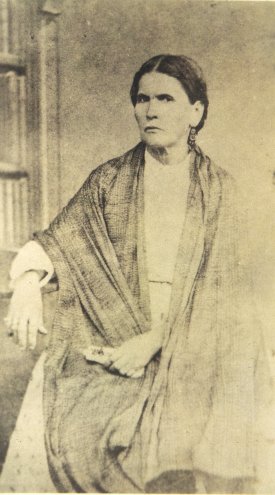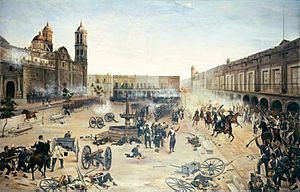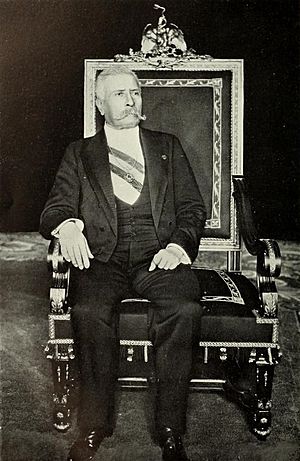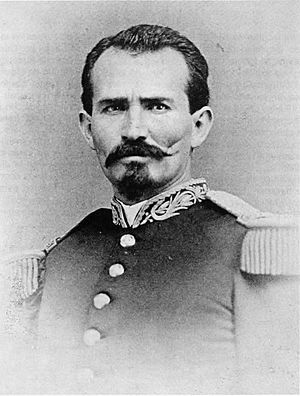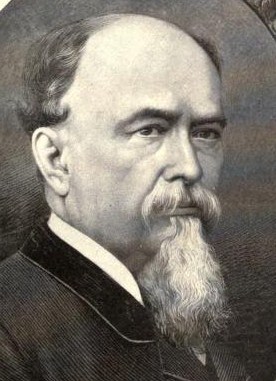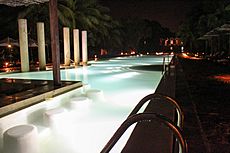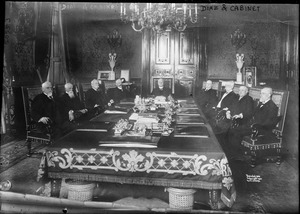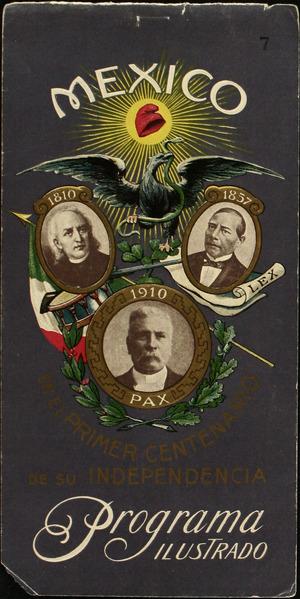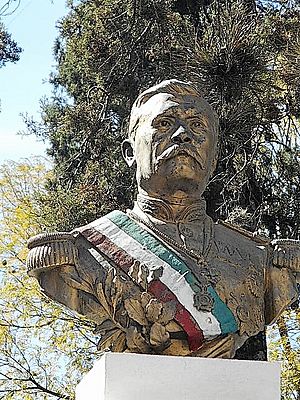Porfirio Díaz facts for kids
Quick facts for kids
Porfirio Díaz
|
|
|---|---|
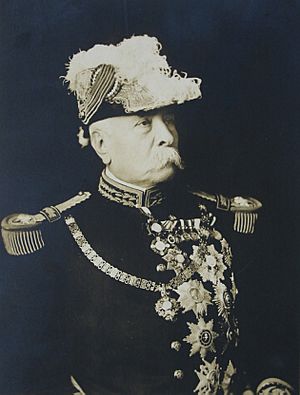
Porfirio Díaz, c. 1910
|
|
| 33rd President of Mexico | |
| In office 1 December 1884 – 25 May 1911 |
|
| Vice President | Ramón Corral |
| Preceded by | Manuel González Flores |
| Succeeded by | Francisco León de la Barra |
| In office 17 February 1877 – 1 December 1880 |
|
| Preceded by | Juan N. Méndez |
| Succeeded by | Manuel González Flores |
| In office 28 November 1876 – 6 December 1876 |
|
| Preceded by | José María Iglesias |
| Succeeded by | Juan N. Méndez |
| Governor of Oaxaca | |
| In office 1 December 1882 – 3 January 1883 |
|
| Preceded by | José Mariano Jiménez |
| Succeeded by | José Mariano Jiménez |
| Secretary of Development, Colonization and Industry of Mexico | |
| In office 1 December 1880 – 27 June 1881 |
|
| President | Manuel González Flores |
| Preceded by | Vicente Riva Palacio |
| Succeeded by | Carlos Pacheco Villalobos |
| Governor of the Federal District | |
| In office 15 June 1867 – 14 August 1867 |
|
| Preceded by | Tomas O'Horan |
| Succeeded by | Juan José Baz |
| Personal details | |
| Born |
José de la Cruz Porfirio Díaz
15 September 1830 Oaxaca City, Oaxaca, Mexico |
| Died | 2 July 1915 (aged 84) Paris, France |
| Resting place | Cimetière du Montparnasse, Paris |
| Political party | Liberal Party |
| Spouses |
Delfina Ortega Díaz
(m. 1867; died 1880)Carmen Romero Rubio
(m. 1881) |
| Children | 8 |
| Parents | José Faustino Díaz María Petrona Mori |
| Profession | Military officer, politician. |
| Signature |  |
| Military service | |
| Allegiance | |
| Branch/service | Mexican Army |
| Years of service | 1848–1876 |
| Rank | General |
| Battles/wars | Second French intervention in Mexico |
Porfirio Díaz (born José de la Cruz Porfirio Díaz Mori; 15 September 1830 – 2 July 1915) was a famous Mexican general and politician. He served as President of Mexico for a total of 31 years. This long period, from 1876 to 1911, is often called the Porfiriato. It was a time when Díaz had almost complete control over the country.
Díaz was a hero from important wars like the Reform War (1858–1860) and the French intervention in Mexico (1862–1867). He led Mexican troops against the French ruler Maximilian I. After these wars, he became president by going against the idea of presidents being re-elected.
His time as president brought stability to Mexico after many years of problems. The economy also grew a lot. However, his policies mostly helped his friends and foreign investors. This often hurt farmers and workers. These policies became very unpopular. This led to protests, strikes, and even small rebellions.
In 1908, Díaz said he would not run for president again. But he changed his mind and ran in the 1910 election. He was 80 years old. After he declared himself the winner, his opponent, Francisco I. Madero, called for a rebellion. This started the Mexican Revolution. In May 1911, Díaz resigned and went to live in Paris, France, where he died four years later.
Contents
- Porfirio Díaz: His Early Life
- Porfirio Díaz: Military Hero
- Porfirio Díaz: Early Political Opposition
- Porfirio Díaz: Becoming President
- Porfirio Díaz: The González Presidency
- Porfirio Díaz: His Administration (1884–1896)
- Porfirio Díaz: The Military
- Porfirio Díaz: Relations with the Catholic Church
- Porfirio Díaz: Economic Growth
- Porfirio Díaz: Challenges to His Power
- Porfirio Díaz: 1910 Centennial of Independence
- Porfirio Díaz: 1910 Election and His Fall
- Porfirio Díaz: Exile and Death
- Porfirio Díaz: Personal Life
- Porfirio Díaz: His Legacy
- Porfirio Díaz: Honors and Awards
- Images for kids
- See also
Porfirio Díaz: His Early Life
Porfirio Díaz was born on 15 September 1830, in Oaxaca, Mexico. This date is important because it's the day before Mexico's Independence Day. His father, José Díaz, was of Spanish background. His mother, Petrona Mori, was a mestiza, meaning she had both Spanish and indigenous roots. His father died when Porfirio was only three years old.
Even though his family faced money problems, Díaz started school at age six. He first trained to become a priest, which was common at the time. But in 1846, when the U.S. invaded Mexico, he joined other students as a soldier. This experience made him decide to join the military instead of the church.
In 1846, Díaz met Benito Juárez, a future president and an important liberal leader from Oaxaca. Díaz later studied law at the Institute of Arts and Sciences. When Antonio López de Santa Anna became powerful again and went after liberals, Díaz joined a rebellion. He fought against Santa Anna's government. After Santa Anna was removed, Díaz got a job in Ixtlán, Oaxaca, which gave him good experience as an administrator.
Porfirio Díaz: Military Hero
Díaz became famous for his role in fighting against the French invasion of Mexico. By the time of the Battle of Puebla on 5 May 1862, he was already a general. This battle was a huge victory for Mexico against the French.
During the battle, Díaz's brigade was in a key position. He successfully helped push back a French attack. His actions were praised by General Ignacio Zaragoza as "brave and notable."
In 1863, the French captured Díaz, but he managed to escape. President Benito Juárez offered him important military positions, but Díaz chose to be the commander of the Central Army. He was promoted to Division General that same year.
Díaz refused offers from Emperor Maximilian to join the imperial side. He was captured again in 1865 but escaped once more. He continued to fight and win important battles. In 1866, he recaptured Oaxaca, taking back much of the land the French had gained in the south. He was then promoted to general.
By 1867, Díaz had won the final battle for Puebla. By the end of the war, he was seen as a national hero for his bravery and leadership.
Porfirio Díaz: Early Political Opposition
After the war, Díaz left the military and returned home. However, he soon disagreed with President Juárez, who wanted to stay in power. Díaz, as a military hero, also wanted to lead the country. He believed that presidents should not be re-elected.
In 1870, Díaz ran against President Juárez. He claimed the elections were unfair when Juárez won. In response, Díaz started a rebellion called the Plan de la Noria in 1871. This rebellion failed, and Díaz's forces were defeated in 1872.
When Juárez died in 1872, Sebastián Lerdo de Tejada became president. Lerdo offered forgiveness to the rebels, and Díaz accepted. He "retired" to a farm. In 1874, Díaz was elected to Congress. But opposition to Lerdo grew, especially as Lerdo became stricter against the Church. Díaz saw another chance to lead a rebellion. He left Mexico in 1875 to plan his next move.
Porfirio Díaz: Becoming President
Díaz started his rebellion in 1876 with the Plan of Tuxtepec. It didn't work at first, and Díaz had to flee to the United States. Lerdo was re-elected, and his government was recognized by the U.S. But Díaz returned to Mexico and defeated Lerdo's forces in the Battle of Tecoac.
In November 1876, Díaz took control of Mexico City. Lerdo left Mexico and went into exile. Díaz didn't become president right away. He put General Juan N. Méndez in charge temporarily. Then, in 1877, new elections were held, and Díaz became president. One of his first actions was to change the constitution to prevent presidents from being re-elected. This was ironic, given his later actions.
The United States did not recognize Díaz's government at first. They wanted Mexico to pay debts and stop cross-border attacks by Apache groups. Díaz agreed to pay $300,000 to settle claims with the U.S. In 1878, the U.S. government finally recognized Díaz. Former U.S. President Ulysses S. Grant even visited Mexico.
During his first term, Díaz learned to handle political problems. He was a practical leader, not focused on strict ideas. He kept control by rewarding his political friends. He also used force when needed, famously saying, "'Five fingers or five bullets.'" He kept elections, but they were often just for show. His main goal was to create peace and order in Mexico. This "Porfirian Peace" (Paz Porfiriana) became a key reason for his long rule.
Díaz and his advisors also worked on a policy called "defensive modernization." This meant inviting U.S. businesses to invest in Mexico. They hoped this would help Mexico grow and become stronger. Díaz famously said, "So far from God, so close to the United States," showing his awareness of Mexico's powerful neighbor.
Porfirio Díaz: The González Presidency
In 1880, Díaz stepped down from the presidency. His friend, General Manuel González, was elected president. This four-year period is sometimes seen as Díaz still being in control, but González made his own decisions. During this time, Díaz briefly served as governor of Oaxaca.
Díaz also focused on his personal life. He married Carmen Romero Rubio, the 17-year-old daughter of an important politician. They traveled to the U.S., where Díaz met with politicians and businessmen, including former U.S. President Ulysses S. Grant. This trip helped improve relations between Mexico and the U.S.
President González brought new people into his government. He also passed laws to encourage foreign investment and settlement in Mexico. However, his government faced financial problems and became unpopular. Díaz's father-in-law even accused González of corruption. Despite his earlier promise of "no re-election," Díaz ran for president again in 1884.
During this time, a new ironic slogan appeared: "Effective suffrage – No. Re-election!" Díaz changed the constitution to allow presidents to serve two terms, and then removed all limits on re-election. With these changes, Díaz was re-elected many times, often with almost all the votes.
For the next 26 years, Díaz built a strong, organized government. His main goal was to bring peace to Mexico after many years of conflict. His second goal was "little of politics and plenty of administration." This meant replacing political arguments with a well-run government.
Porfirio Díaz: His Administration (1884–1896)
To keep his power, Díaz used a mix of rewards and control. He tried to balance the needs of different groups. After González's presidency, Díaz started choosing ministers from different political groups, not just his own. This included people who had supported Juárez or Lerdo.
As foreign money came into Mexico, Díaz could reward his loyal supporters. Foreign investors, especially from the U.S. and Great Britain, were a key group supporting his government. Díaz himself met with these investors, creating strong personal ties.
Díaz also gave political jobs to indigenous leaders and rural elites. This helped keep them happy and connected to his government. The middle classes in Mexico City also found job opportunities as the government grew.
Díaz was different from earlier liberal leaders. He did not attack the Catholic Church, but he also didn't fully protect it. He was a Freemason but also advised Catholic bishops. He allowed Protestant missionaries to come to Mexico.
Díaz stopped opposition parties from forming. He took control of local governments, and state governors reported directly to him. His closest friends held high positions in government. Congress usually approved his plans, even changing the constitution to allow him to be re-elected. Díaz also controlled the press and the courts. He would step in if political issues threatened stability.
A very important supporter of Díaz was Manuel Romero Rubio, his father-in-law. Many historians believe Romero Rubio helped design the way Díaz's government worked. One of Romero Rubio's students, José Yves Limantour, became the main financial advisor. Limantour's group, called the Científicos (meaning "scientists"), wanted to make the government more efficient and fair. However, Díaz preferred to keep control himself.
Porfirio Díaz: The Military
Díaz became a military leader during a very difficult time in Mexico. This included the U.S. invasion, the Reform War, and the French Intervention. Many of his early government officials were also military veterans.
However, Díaz slowly reduced the power of military figures in his government. Civilian politicians who were loyal to him became more important. His government was not a military dictatorship, but it had strong civilian allies.
Díaz brought local military leaders under the control of the central government. He gave them good salaries to keep them loyal. He also sent dangerous military leaders on trips abroad to keep them out of Mexico. He created military zones that didn't match state borders and regularly moved commanders around. This stopped them from gaining too much power in one area. Díaz built a national army that supported his government.
The Mexican Federal Army often had poorly paid soldiers who were forced to join. Díaz increased the military budget and started to modernize the army. He also expanded the Rurales, a special police force under his direct control. Díaz knew it was important to stop banditry, so the Rurales protected major transport routes. By 1910, the Federal Army had older leaders and unhappy soldiers. They struggled to control the rebellions that started the Mexican Revolution.
Porfirio Díaz: Relations with the Catholic Church
Unlike many other Mexican liberals, Díaz was not against the Catholic Church. This helped him gain support from conservatives and the Church itself when he came to power.
Earlier liberal leaders had passed laws to limit the Church's power. These laws aimed to make everyone equal and reduce the Church's economic influence. The Lerdo law, for example, forced the Church to sell its property. The 1857 constitution also reduced the Church's special position and allowed other religions.
When Díaz became president in 1877, he kept these anti-Church laws in place but didn't strictly enforce them. He left it up to individual states to decide. This allowed the Church to become more visible again. Priests started wearing religious clothes in public, and religious ceremonies were held outside. The Church also started to get its property back and collected tithes again. It regained its role in education and charity.
This agreement between Díaz and the Church was practical. Díaz didn't publicly go against liberal ideas, so the 1857 Constitution remained. But by not enforcing the anti-Church laws, he avoided conflict. The Church regained significant economic power and its role in society. Important events like the return of the Jesuits and the crowning of the Virgin of Guadalupe showed the Church's growing influence. When the Mexican Revolution began in 1910, the Catholic Church strongly supported Díaz's government.
Porfirio Díaz: Economic Growth

Díaz wanted to attract foreign money to Mexico to help develop mining, farming, industry, and transportation. He created a stable political environment and updated laws to make investors feel safe. Railways, built with foreign money, connected remote areas to markets.
The government also surveyed land, which helped investors get clear ownership. However, this often hurt local communities and indigenous people who couldn't prove their land ownership. Survey companies got a share of the land they measured, often selling it to foreigners. This led to large amounts of Mexican land falling into foreign hands.
Foreigners bought land for growing crops like coffee, rubber, and sugar for export. Traditional grazing lands were fenced off. Many rural communities and small farmers lost their land. They were forced to work for low wages on large farms or move away. These harsh conditions led to widespread unhappiness and were a major cause of the Mexican Revolution. Many peasants joined the revolution hoping for land reform.
For the wealthy, this was a "golden age" for Mexico's economy. Mexico was compared to powerful countries like France and Germany. However, this progress was not spread evenly. The north focused on mining and ranching. The central valley had large farms and industrial centers.
Foreign investment also boosted Mexico's mining industry. For example, Díaz gave a French company a 70-year tax break to develop the El Boleo copper mine in Baja California. This led to the creation of the town of Santa Rosalía. The city of Guanajuato also saw a lot of foreign investment in silver mining. This brought prosperity and led to the building of beautiful landmarks like the Juárez Theatre. By 1900, over 90% of communal land in the Central Plateau had been sold or taken. This forced 9.5 million peasants off their land and into working for big landowners.
Díaz's strong central government helped him manage economic problems. But this stability came at a cost: many peasants lost their land. The Porfiriato created a huge gap between fast economic growth and the sudden poverty of many rural people. This situation eventually led to the Mexican Revolution in 1910.
Porfirio Díaz: Challenges to His Power
Díaz was like a "republican monarch" who combined old ways with new ideas. He became a symbol of the nation. However, he didn't plan well for who would take over after him. As he got older and kept being re-elected, the question of who would be the next president became more urgent. People within his government and opponents started preparing for his departure.
Around 1898, Díaz faced new challenges. His long-time advisor, Matías Romero, who had worked to strengthen ties with the U.S., died. Also, the U.S. became more powerful after winning the Spanish–American War. Romero's death weakened his pro-American group.
Two other important groups were the Científicos, led by José Yves Limantour, and the Reyistas, followers of General Bernardo Reyes. Limantour tried to balance U.S. influence by encouraging European investment. U.S. investment in Mexico still grew, but the economic situation became less favorable for them.
The U.S. claimed a leading role in the Western Hemisphere with the Roosevelt Corollary. This meant the U.S. could interfere in other countries if they weren't well-governed. Díaz disagreed, saying all nations in the Americas should work together for security. At a meeting in Mexico City in 1901-1902, the U.S. softened its stance towards Mexico.
In Mexico, Bernardo Reyes became more powerful. Díaz made him Minister of War. The Mexican Federal Army was not very effective. Reyes asked for more money to increase the number of soldiers, especially because of ongoing wars against the Yaqui and Maya peoples.
There was some public opposition to Díaz. An unusual lawyer named Nicolás Zúñiga y Miranda ran against Díaz in every election. He always claimed fraud and believed he was the rightful president, but he never posed a serious threat. As the 1910 election approached, Díaz hinted he might not run again. This led to a competition between Limantour and Reyes for who would be the next leader.
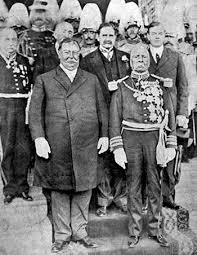
On 17 February 1908, Díaz told a U.S. journalist that Mexico was ready for democracy. He said he would retire and allow other candidates to run. Many groups started looking for candidates. Some liberals supported Bernardo Reyes. But Díaz saw Reyes as a threat and sent him to Europe, so he wouldn't be in Mexico for the elections.
In 1909, Díaz met with U.S. President William Howard Taft in El Paso, Texas, and Ciudad Juárez, Mexico. This was the first time a U.S. president crossed into Mexico to meet a Mexican president. Díaz wanted to show that the U.S. supported his plan to run for a seventh term. Taft agreed to protect the large U.S. investments in Mexico. By then, U.S. businesses controlled much of Mexico's resources. Security was very tight for the meeting. On 16 October, a man with a hidden pistol was caught near Díaz and Taft.
Porfirio Díaz: 1910 Centennial of Independence
The year 1910 was very important for Mexico. It marked 100 years since Miguel Hidalgo started the Mexican War of Independence. The official program for the centennial showed three important figures: Hidalgo, Benito Juárez (representing law), and Porfirio Díaz (representing peace).
Díaz opened the monument to Independence during the September celebrations. Even though Díaz and Juárez had been rivals, Díaz did a lot to honor Juárez's memory. He had a large monument to Juárez built and opened it during the centennial. The celebrations lasted for 30 days in September 1910.
Porfirio Díaz: 1910 Election and His Fall
As the 1910 election neared, Díaz decided not to retire. He allowed Francisco I. Madero, a wealthy but reform-minded landowner, to run against him. Madero was similar to Díaz in some ways, but he wanted other elites to share power with the president. However, Díaz eventually had Madero arrested during the election.
The election went ahead. Madero had gained a lot of public support. But when the official results were announced, Díaz was declared the winner with almost all the votes. Madero was said to have received very few votes. This massive election fraud made many Mexicans very angry.
Madero then called for a rebellion against Díaz in the Plan of San Luis Potosí. This uprising is now seen as the first part of the Mexican Revolution. Rebellions broke out in many places, and the Federal Army and the Rurales struggled to control them all. This showed how weak Díaz's government had become. Díaz was forced to resign from office on 25 May 1911. He left Mexico for Spain six days later, on 31 May 1911.
Porfirio Díaz: Exile and Death
Díaz kept his nephew, Félix Díaz, away from political or military power. He did allow his nephew to become wealthy. Only after Díaz went into exile in 1911 did Félix become important in politics. However, Díaz's judgment of his nephew was correct, as Félix never successfully led troops or gained lasting support. He was forced into exile several times himself.
Porfirio Díaz died in exile in Paris, France, on 2 July 1915. He was buried in the Cimetière du Montparnasse. His widow, Carmen, and his son were later allowed to return to Mexico.
Porfirio Díaz: Personal Life
Díaz came from a very Catholic family. His relative, José Agustín Domínguez y Diaz, was a bishop in Oaxaca. Díaz himself trained to be a priest. However, Oaxaca was a center for liberal ideas, and Díaz chose a military career instead. His powerful uncle disowned him for this decision.
Díaz married his niece, Delfina Ortega Díaz, in 1867. They had seven children, but Delfina died after her seventh delivery in 1880. After her death, Díaz privately wrote to Church officials to allow his wife to be buried in sacred ground with Catholic rites.
Díaz also had a daughter named Amada Díaz (born 1867) with a woman named Rafaela Quiñones during the French Intervention. He recognized Amada, and she lived in his home with his wife Delfina. Amada later married Ignacio de la Torre y Mier, but they had no children.
In 1881, Díaz married Carmen Romero Rubio, the 17-year-old daughter of his most important advisor, Manuel Romero Rubio. A priest from Oaxaca, Father Eulogio Gillow y Zavala, gave his blessing. Doña Carmen is often credited with helping Díaz improve his relationship with the Church. This marriage did not produce any children, but Díaz's surviving children lived with the couple until they were adults.
In 1938, a collection of 430 weapons belonging to General Porfirio Díaz was given to the Royal Military College of Canada in Kingston, Ontario.
Even though Díaz is criticized for many things, he did not try to create a family dynasty. His only son who lived to adulthood, Porfirio Díaz Ortega, became a military engineer but never fought in combat. He and his family went into exile after Díaz resigned. They were allowed to return to Mexico later.
Porfirio Díaz: His Legacy
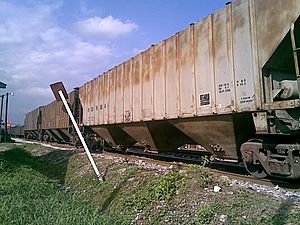
The way people view Porfirio Díaz has changed over time. During his rule, there were many writings praising him. After he was removed from power, many writings called him a tyrant and dictator. This view has largely shaped his historical image. However, in recent years, some historians have tried to show Díaz in a more positive light. They point to his policies that opened Mexico to foreign investment.
Díaz is often credited with the saying, "¡Pobre México! ¡Tan lejos de Dios y tan cerca de los Estados Unidos!" (Poor Mexico, so far from God and so close to the United States!).
Because Díaz ruled for so long, the current Mexican constitution limits a president to a single six-year term. No one can be re-elected, even if it's not immediately after their term. This rule is very strong in Mexico.
There have been several attempts to bring Díaz's remains back to Mexico since the 1920s. The most recent effort started in 2014 in Oaxaca. Some believe that the fact his remains are still in Paris shows that Mexico has not fully come to terms with Díaz's time in power.
Porfirio Díaz: Honors and Awards
Porfirio Díaz received many awards from different countries during his time as president:
| Country | Awards |
|---|---|
| Austria-Hungary | Grand Cross of the Royal Hungarian Order of St. Stephen |
| Belgium | Grand Cordon of the Order of Leopold |
| China's Qing Dynasty | First Class Condecoration of the Imperial Order of the Double Dragon |
| France | Napoleon's Austerlitz sword Grand Cross of the Legion of Honour |
| Kingdom of Italy | Knight of the Grand Cross of the Order of Saints Maurice and Lazarus |
| Empire of Japan | Grand Cordon of the Order of the Chrysanthemum |
| Netherlands | Knight Grand Cross of the Order of the Netherlands Lion |
| Persia's Qajar dynasty | First Class Condecoration with Grand Cordon of the Order of the Lion and the Sun |
| Kingdom of Prussia | Grand Cross of the Order of the Red Eagle |
| Kingdom of Portugal | Grand Cross of the Order of the Tower and Sword |
| Russian Empire | Star of the Imperial Order of St. Alexander Nevsky |
| Spain | Grand Cross of the Order of Isabella the Catholic Grand Cross of the Order of Military Merit |
| Sweden | Commander Grand Cross of the Order of the Sword |
| United Kingdom | Honorary Knight Grand Cross of the Most Honourable Order of the Bath |
| Venezuela | First Class of the Order of the Liberator |
| Kingdom of Hawaii | Grand Cross of the Royal Order of Kalākaua I |
Images for kids
See also
 In Spanish: Porfirio Díaz para niños
In Spanish: Porfirio Díaz para niños


